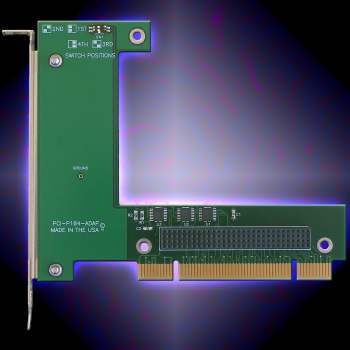PCI-P104-ADAP
FEATURES
- Permits a PC/104-Plus board to be installed in a PCI slot
- Universal PCI, PCI-X, 3.3V and 5V compatible
- Allows for convenient debugging, testing, and software development
- Switches allow user to simulate the position of the board in the stack
- Unique layout allows for easy access to both sides of the PC/104-Plus board and provides more room for cabling
- Connections made via 4x30 (120-pin) 2mm pitch PCI-104 connector
- Standard PCI card size

Model PCI-P104-ADAP simply allows for the installation of a PC/104-Plus or PCI-104 board into any Universal PCI, 3.3V or 5V slot. It is a standard PCI bus card that supports 32-bit wide data transfers to and from a PC/104-Plus board. This allows any user the convenience of hardware testing, software development, and debugging of a PC/104-Plus board in a PC environment.
The unique layout of the adapter card allows easy access to both the front and the back of the PC/104-Plus board. This feature enables the user to probe the front and back of the PC/104 board easily and also provides more room for cabling.
The PCI-P104-ADAP provides an environment to simulate a PC/104-Plus stack, and the boards position in a stack. Only four boards are allowed in a PC/104-Plus stack. Most PCI bus signals are common to all four boards in the stack. However, there are four unique signal groups, one for each board position. Each board must get a specific set (out of four sets) of signals: Bus Grant, Bus Request, Clock, ID Select, and Interrupt. Slide switches on the adapter card select which signal group goes to the attached PC/104-Plus board.
The PCI bus clock trace length from the CPU to the modules in the stack is tuned so that the clock edge arrives at the interface when data is valid. Since modules in the PC/104 stack are at different distances from the CPU, a provision is made on the CPU board to supply four clock signals with compensating trace lengths. Four signals from the other groups must also be selected: GNTx, REQx, IDSELx, and INTx. When the PCI bus is being initialized, the operating system will enable each card with a hard-wired select line and read it's configuration registers. An address is assigned, space in the memory map and I/O map is reserved, etc. Similarly, the CPU's interrupt signals (INTA, INTB, INTC, INTD) will be distributed among the boards in the stack. Five 4:1 multiplexers and the two slide switches are used to select which signals are routed to the card's PCI/104 bus connector.
Drivers and Downloads
Full list of available Downloads: Software Packages, Drivers, Manuals, and other documents
Custom Software
ACCES also offers Custom Software Services for our products. Our prices are unbelievably low, often as inexpensive as free! If you need something tweaked to support your needs, or an entire enterprise application developed from scratch, it is definitely worth your time to inquire with us, first.
Further information about available ACCES Software:
- Redistributing Windows Drivers
- A list of ACCES drivers and the files that compose them under different versions of Windows, so you can easily redistribute ACCES cards and drivers.
| Model | Price (USD) |
|---|---|
| PCI-P104-ADAP | 139.00 |